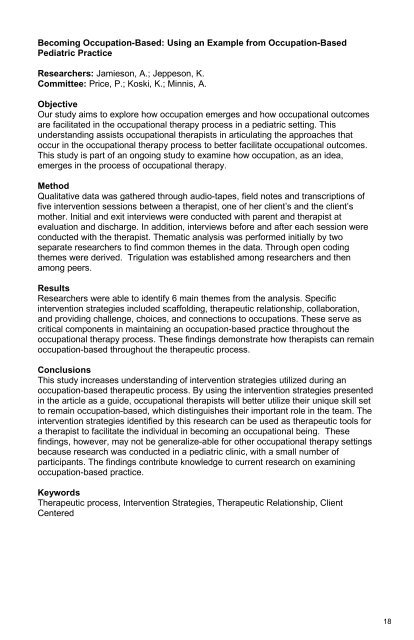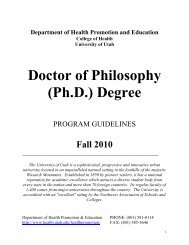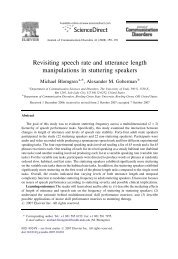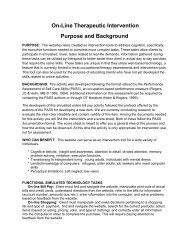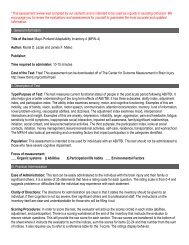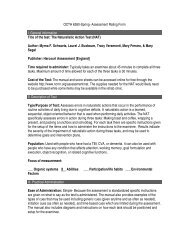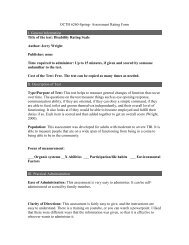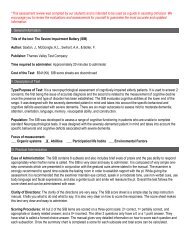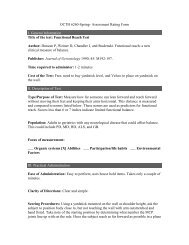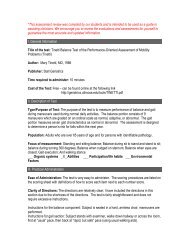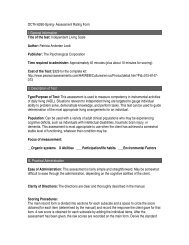2011 Symposium Program - College of Health - University of Utah
2011 Symposium Program - College of Health - University of Utah
2011 Symposium Program - College of Health - University of Utah
You also want an ePaper? Increase the reach of your titles
YUMPU automatically turns print PDFs into web optimized ePapers that Google loves.
Becoming Occupation-Based: Using an Example from Occupation-Based<br />
Pediatric Practice<br />
Researchers: Jamieson, A.; Jeppeson, K.<br />
Committee: Price, P.; Koski, K.; Minnis, A.<br />
Objective<br />
Our study aims to explore how occupation emerges and how occupational outcomes<br />
are facilitated in the occupational therapy process in a pediatric setting. This<br />
understanding assists occupational therapists in articulating the approaches that<br />
occur in the occupational therapy process to better facilitate occupational outcomes.<br />
This study is part <strong>of</strong> an ongoing study to examine how occupation, as an idea,<br />
emerges in the process <strong>of</strong> occupational therapy.<br />
Method<br />
Qualitative data was gathered through audio-tapes, field notes and transcriptions <strong>of</strong><br />
five intervention sessions between a therapist, one <strong>of</strong> her client’s and the client’s<br />
mother. Initial and exit interviews were conducted with parent and therapist at<br />
evaluation and discharge. In addition, interviews before and after each session were<br />
conducted with the therapist. Thematic analysis was performed initially by two<br />
separate researchers to find common themes in the data. Through open coding<br />
themes were derived. Trigulation was established among researchers and then<br />
among peers.<br />
Results<br />
Researchers were able to identify 6 main themes from the analysis. Specific<br />
intervention strategies included scaffolding, therapeutic relationship, collaboration,<br />
and providing challenge, choices, and connections to occupations. These serve as<br />
critical components in maintaining an occupation-based practice throughout the<br />
occupational therapy process. These findings demonstrate how therapists can remain<br />
occupation-based throughout the therapeutic process.<br />
Conclusions<br />
This study increases understanding <strong>of</strong> intervention strategies utilized during an<br />
occupation-based therapeutic process. By using the intervention strategies presented<br />
in the article as a guide, occupational therapists will better utilize their unique skill set<br />
to remain occupation-based, which distinguishes their important role in the team. The<br />
intervention strategies identified by this research can be used as therapeutic tools for<br />
a therapist to facilitate the individual in becoming an occupational being. These<br />
findings, however, may not be generalize-able for other occupational therapy settings<br />
because research was conducted in a pediatric clinic, with a small number <strong>of</strong><br />
participants. The findings contribute knowledge to current research on examining<br />
occupation-based practice.<br />
Keywords<br />
Therapeutic process, Intervention Strategies, Therapeutic Relationship, Client<br />
Centered<br />
18


